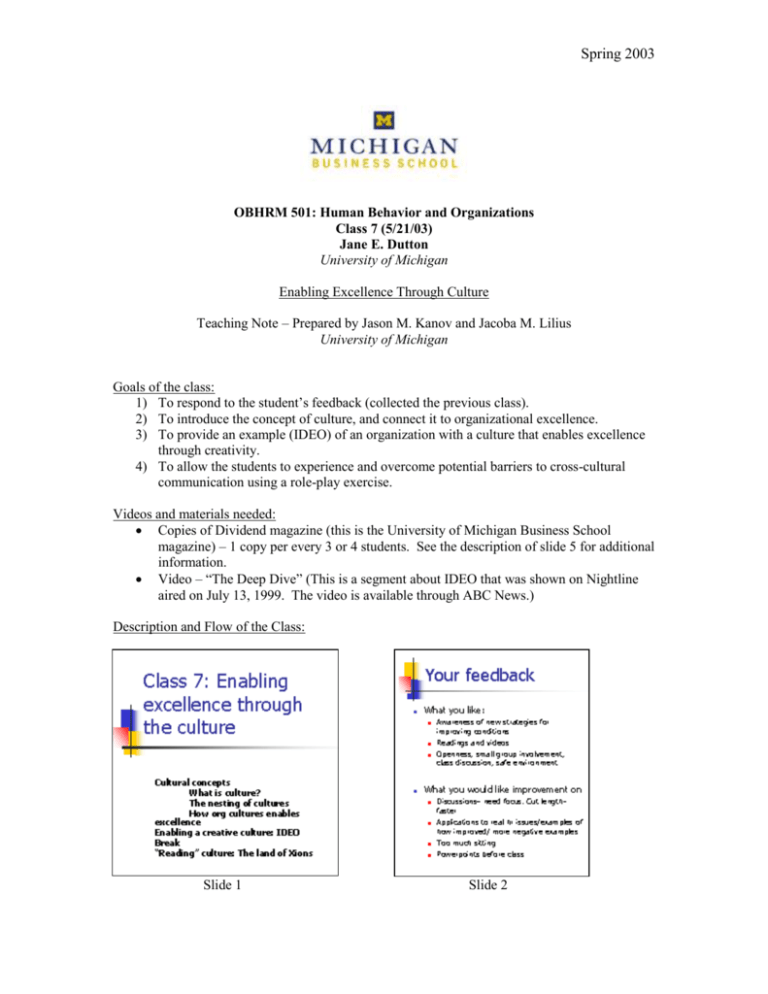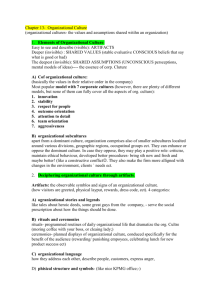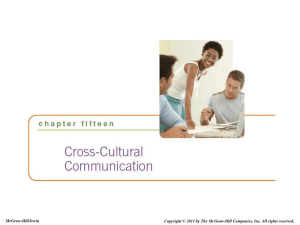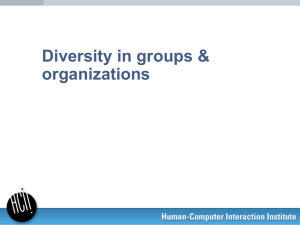Class 7 - Center for Positive Organizations
advertisement

Spring 2003 OBHRM 501: Human Behavior and Organizations Class 7 (5/21/03) Jane E. Dutton University of Michigan Enabling Excellence Through Culture Teaching Note – Prepared by Jason M. Kanov and Jacoba M. Lilius University of Michigan Goals of the class: 1) To respond to the student’s feedback (collected the previous class). 2) To introduce the concept of culture, and connect it to organizational excellence. 3) To provide an example (IDEO) of an organization with a culture that enables excellence through creativity. 4) To allow the students to experience and overcome potential barriers to cross-cultural communication using a role-play exercise. Videos and materials needed: Copies of Dividend magazine (this is the University of Michigan Business School magazine) – 1 copy per every 3 or 4 students. See the description of slide 5 for additional information. Video – “The Deep Dive” (This is a segment about IDEO that was shown on Nightline aired on July 13, 1999. The video is available through ABC News.) Description and Flow of the Class: Slide 1 Slide 2 Spring 2003 Slide 1 This slide provides a brief overview of the flow of the class. Slide 2 This slide summarizes the mid-term feedback the students provided in the previous class. The slide describes what the students seem to enjoy about the class, and it also identifies some aspects of the class that could be improved. In addition to listing the areas that could be improved, it is a good idea to also describe any efforts you will be making in order to make these improvements. [Reviewing this feedback with the class should take approximately 5 minutes.] Slide 3 Slide 3 Slide 4 This slide introduces some basic ideas about organizational culture. Additional thoughts: There are many definitions of culture that exist in the organizational literature, but the one that appears on this slide (shared assumptions, beliefs and values that distinguish a social collective and shape patterns of behavior) is the one that fits best with purposes of the class. Culture can be hard to put your finger on. That is, it is difficult to say exactly what an organization’s culture is like, yet at the same time, it is very easy to feel when you enter an organizational context. Slide 4 The information in this slide is based on the Schein coursepack reading. It describes three levels of culture, from the most to the least visible (artifacts being the most visible and basic underlying assumptions being the least visible). As a way of transitioning to this slide, explain that it is at the level of artifacts that culture is tangible, but that it is at the level of basic assumptions that culture is truly defined. Spring 2003 Note that culture is very difficult and very slow to change because it is these assumptions that must be changed – it would take at a minimum 10 years to make a real culture change. Connect this difficulty with the notion that new strategies are often implemented without consideration of the basic culture to explain why change efforts often fail—it leads to situations in which organizational culture and strategy are not aligned. Slide 5 Slide 5 Slide 6 This slide describes a break out exercise that is intended to get the students to identify concrete aspects of the three levels of culture in a real organization. The organization that will be investigated is the University of Michigan Business School. For this activity, students are asked to break into groups of 4 and each group is given a copy of the University of Michigan Business School’s Dividend magazine. Groups are then asked to identify evidence of cultural artifacts, espoused values, and basic underlying assumptions based on what they see in the magazine and what they know or have experienced as members of the business school. (10 minutes) Discussion about the group activity (15-20 minutes): This discussion gives the groups an opportunity to share their ideas with the class. To enrich the discussion, you may also want to prompt them to reflect on other related cultural levels. For example, if they identify a cultural artifact, try to push them to think about what this artifact suggests in terms of cultural values or underlying assumptions Spring 2003 Sample responses: Artifacts – Limousines that take executives to and from the airport (The students are then pushed to think about what this artifact suggests in terms of values or assumptions) o Some responses: care for stakeholders; elitism; arrogance Artifacts Beautiful surroundings (e.g. courtyard) Diversity in featured career opportunities Tozzi Center Alumni connections Espoused Values We are a world class business school Be interdisciplinary Basic Underlying Assumptions Aesthetics reflect quality We want to be high tech and connected to Wall St. You should give back Technology is the way to advancement It is important to foster the next generation of students Diversity in background and experience is beneficial to the learning experience. Success = $$$ Cultural diversity We strive to maintain a diverse student population Limousines for executives We care about prestige Slide 6 Well-roundedness is important This slide depicts a figure that has been developed by members of the business school (from the deans to the support staff) as an articulation of their new strategy, “Leading in Thought and Action”. The top section of the figure says, “Conjoining Theory and Action”. The middle left section says, “Innovating In Business Education”. The middle right section says, “Capitalizing On CoCreation Opportunities”. The base of the triangle says, “Developing BroadBased Intellectual Capital With Impact”. The purpose of this slide is to foster discussion about alignment between a new strategy and organizational culture. For example, the triangle is a representation of the Business School’s strategy. It was used to engage students in a discussion about how the current Business School culture supports (or not) the strategy. Slide 7 Slide 8 Spring 2003 Slide 7 This slide helps the students to see how cultures can be nested within other cultures. For example, the culture of the Business School (unit culture) is nested within the U of M’s organizational culture, which is nested within the professional-industry culture, which is nested within a national culture. Slide 8 Video – “The Deep Dive” (25 minutes): This slide provides the students with some guiding questions to keep in mind as they watch a video clip featuring IDEO. The purpose of this video is to provide students with a concrete example of a positively deviant organization for analysis and discussion. IDEO is an organization with a strong culture that encourages excellence through creativity. Discussion about the video (20 minutes): The guiding questions from slide 8 can be used to initiate the discussion. As students identify aspects of the culture, ask them to think about the aspects of the organizational practices and process that enable these aspects. Offer your own insights to connect the students’ comments to the main ideas you are trying to convey. How would you describe the culture? Sample responses: open; encouraging of people to be creative; fun; there is personality in every cubicle; non-threatening; value placed on out-ofthe-box thinking; not experts at products, but process; judgment is suspended How is the culture created and sustained? Sample responses: flat (non-hierarchical) structure; recruiting and hiring practices (selecting for diversity in background and attitudes); evaluation practices (peer evaluations); rewarding groups (not individuals) Slide 9 Slide 10 Spring 2003 Slide 9 This slide is a quote from the CEO of IDEO that is used to demonstrate the concept of mindfulness as a collective process. Note that this process is very difficult to imitate as a competitor. Slide 10 This slide is very important because is makes the link between organizational culture and excellence. As you go through the points on this slide that describe how culture can enable organizational excellence, try to connect the points back to concrete examples from the IDEO video or other examples that may have come up in discussion. Break (10 minutes) The second half of the class uses a role-playing exercise to provide students with an opportunity to experience some potential difficulties associated with crosscultural communication and interaction. Although the activity that Jane used in teaching this class is not available, the following is a brief description of the activity that will hopefully help you select or develop an activity that fits with the goals of this class. The premise of the activity that Jane used is as follows: American journalists must negotiate with ‘Xions’ (people from a fictional foreign land) in order to gain permission to take pictures of gardens that have never before been photographed. While this is not made explicit prior to the exercise, the Xions have many different cultural norms and expectations that the Americans must pick up on and follow if they are to gain access to the gardens. This is a group activity such that each student will be a member of a group of either three Xions or three American journalists. During the activity, each group of Xions will be paired with a different group of Americans. If the number of students in the class is not divisible by 6, the extra students can act as observers for the interactions. Once the groups are formed, the Xions and the Americans should be separated, given instructions about their respective roles, and given about 10 minutes to prepare for their roles. When the activity begins the Americans should spend some time getting to know the Xions before attempting to make their request. As a way of debriefing the activity, begin by discussing what happened across all of the groups and then discuss the challenges that groups faced during the activity. Below are some examples of discussion questions: How many groups achieved their outcome? (It may be that the majority of groups will be unsuccessful.) What was the most difficult part about this interaction? What approaches worked (or did not work)? What were the keys to success (for those groups that succeeded)? What role, if any, did stereotyping play during this activity? What did you do to build a positive connection during the interaction? (E.g., you could express interpersonal attunement by asking questions like “Do you understand English?” or “Do you want me to slow down?”) Spring 2003 It is also important to spend some time discussing the broader implications of challenges faced in this activity. How can you utilize your experience here today or your experience in industry to lead you to cross-cultural competence? o Sample responses: ease into the culture; engage fully in the culture (ask many questions); show respect through interest; share aspects of own culture; research the other culture carefully before attempting to interact (noted that in this case, many of the barriers to communication could have been avoided with even basic research that the students didn’t have opportunity to conduct); keep an open mind. o Additional thought: An important part of cross-cultural competence is being able to show it – for example, being able to indicate that you are keeping an open mind. How do you do this? Slide 11 Slide 11 Slide 12 Use this slide to summarize and expand on the difficulties that the students identified during the debriefing of the activity. It is important to emphasize how challenging these difficulties may be to overcome. Note that even in the present exercise in which people may have had a heightened awareness of cultural barriers, they were still very difficult to work through. Courtesy conventions – Each culture has conventions for courtesy– people who don’t conform to these conventions may viewed as rude. For example, the American convention of asking, “How are you?” without expecting an answer may create an impression that Americans are insincere to those from other cultures. Spring 2003 Phasing – This can affect how and when business subjects are discussed. Different expectations exist across cultures about necessities and wasting time as do different assumptions about mixing business with pleasure. Objectivity – Culture affects the preferences and expectations about logic, precision, and orderliness. Less orderly can seem chaotic; being precision–oriented can seem intolerant and demeaning. Specificity – Cultures differ in terms of how specific one should be at the start of a discussion. For example, white Americans tend to start with specifics and what are considered important points and then expand. Asians prefer to start with generalities and go to details. Assertiveness – Major cultural differences exist in the preferences and appropriateness of being self-effacing vs. self-promoting. Different behaviors in different cultures would be interpreted as friendly vs. confrontational vs. aggressive. Candor Differences – There exist differences across cultures in terms of the priority given to candor in communication. For example, Americans often feel telling the truth is key. In other cultures, courtesy, sensitivity, loyalty to family, and face are much more important.Slide 12 This slide summarizes what the main points about culture. Note the potential for positive dynamics of organizational culture and juxtapose it with the potential negative dynamics of cross-cultural barriers. The next class is about physical and social architecture. Jane asked students to come to class with ideas or artifacts regarding physical spaces that might enable excellence.







